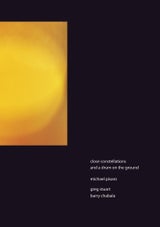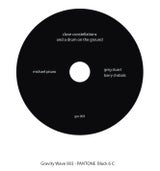Michael Pisaro/Greg Stuart/Barry Chabala - Close Constellations And A Drum On The Ground (CD)
SKU:
$14.00
$12.00
$12.00
On Sale
Unavailable
per item
GW 003
CD inside a cardboard folder with liner notes info, transparent plastic cover.
|
TRACK LIST/CREDITS
Close Constellations And A Drum On The Ground (2010) to luka zagoricnik percussion samples performed and recorded by Greg Stuart Barry Chabala-electric guitar Greg Stuart-crotales mixed and mastered by Michael Pisaro design by Yuko Zama (released March 2, 2011) |
'Close constellations and a drum on the ground' (2010) began as scored work with electronics but then developed a life of its own in the studio. It consists of the alternation of sedimentary layers of low percussion samples (mixed with guitar and many noise sources) in slow rotation, and clusters of slowly modulating high sine waves pierced by bowed crotales. (40’20”)
REVIEWS
Brian Olewnick, Just Outside Scored for guitar and crotales (bowed) with sine tones and drum samples, performed by Barry Chabala and Greg Stuart (I take it Pisaro himself administers the sines and samples during assemblage of the disc?). It's in eight sections of five minutes each, alternating between guitar and crotales (with accompaniment), the number of held tones progressing 1-1-2-3-4-5-6-7. These notes form long melodic lines which is part of the crux of this work and the following one and marks a path that Pisaro seems to have embarked on the past couple of years, a more overtly intuitive and, one might even say, within the limits he's set, gestural sensibility. If that's the case (I'm not sure if he'd dispute it), it arises from years of more severe discipline and is enormously enhanced by that earlier, more astringent rigor. In this case, the structure, simple enough in its large-scale form, is perhaps more felt than directly perceived, minimal as its additive nature is and stretched out over significant time periods. But I do think that feeling resonates and provides a kind of webbing for the shorter elements. Additionally, the placement of tones by each performer, in each section, varies somewhat, from occupying an entire duration, to only beginning at a certain point for a specified number of seconds within a duration, to choosing where inside a given duration to place one's portion of sound, so that within this structure, there's an amount of movement, of differentiation that, again, is less immediately apparent than felt. The increase of notes over the course of the piece also provides a necessary "hastening" of the lines though, again, as it spans relatively long lengths, one is not likely to notice this unless one is purposely looking. (These time brackets go from 240 seconds to 150, 120, 40 within 150, within 75, within 40, within sections of 40, 40, 35, 55, 30 and 60, and finally, unison crotales and sine tones of lengths 30, 30, 40, 45, 30, 20 and 40.) How does it all sound then? Well, rather marvelous. The two basic sounds, e-bowed guitar and bowed crotales, are akin but differentiated enough, but not so dissimilar from the sine tones weaving in and out. It's the percussive samples, though, that provide the off-and-on "bed" for the ears, a kind of cushion in which to sink. These samples, however they were generated, give the appearance of muffled, blurred field recordings in fact, like fuzzy traffic or the rumbles of industrial facilities. But more interestingly, to me, is the fact that, by using a number of longish segments with discernible if faint variation within, as opposed to an even longer but more steady-state work, Pisaro forces you to really try to perceive the pieces in relation to the whole and to each other. By noticeably dividing the work, he manages to increase the perceived scale. You have to remember a good deal to get a feel of the more or less additive sequences that are in play, but it's a very complex thing as those structural aspects are "pointing" one way while other elements, like the dynamics, pitches, etc. point in opposite or perpendicular directions. It's very much like certain fundamentals of nature, if I may be so bold: a general thrust along one line, perhaps largely hidden, while all manner of contrary activity takes place "above", even as it's carried along by the substratum. Really, there's a ton to gnaw on here and I feel I've only scratched the surface. This will doubtless repay many hours or re-listening. The damn thing just sounds so good, as well. A great, great piece. (3/23/2011) |



